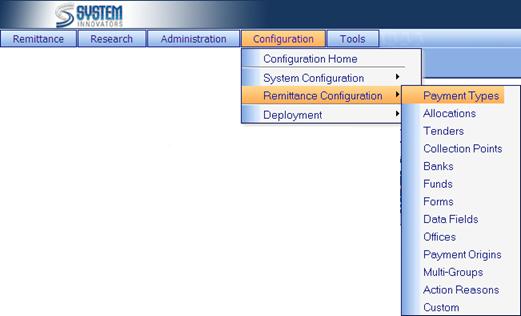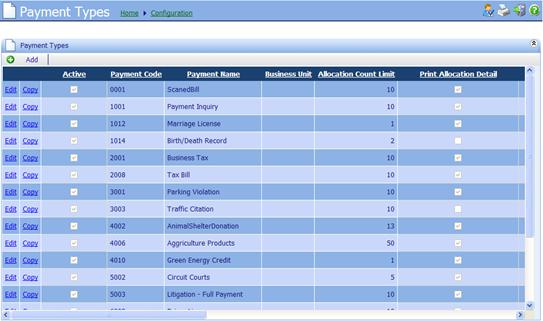
A
payment type identifies the name of a payment, such as electricity payment,
water payment, or any type of payment which may be processed by an
organization.
Allocations: In order for a Payment Type
to be valid, at least one Allocation must be assigned to it.† When a Payment is collected only Allocations
assigned to that Payment Type may be used. An Allocation can also be assigned
to a Payment Type when the Allocation is being configured.
Tenders: Each payment type must be
assigned at least one tender. When a payment is collected, only tenders
assigned to that payment type may be collected for the payment.† For example, an agency might accept only cash
and money order for child support payments. As such, only the cash and money
order tenders would be assigned to the child support payment type. A tender can
also be assigned to a payment type when the tender is configured.
Interfaces: Each payment type may be
assigned a payment inquiry interface or a payment update interface. The payment
inquiry interface determines the type of inquiry that is performed for a given
payment type. For example, account inquiries for property tax payments and
vehicle registration payments might be processed on different host systems. As
such, the appropriate payment inquiry interface would be assigned to each
payment type. The payment update interface determines the host system that a
given payment type is forwarded to during a payment update. A system interface
can also be assigned to a payment the when the system interface is being
configured.
A
Payment Type can be either Active or Inactive.†
Payment Types cannot be deleted. If a Payment Types is no longer needed,
make the Payment Type inactive.
The Payment Types page is located at Configuration>Remittance
Configuration>Payment Types.

(Example of
the Payment Types page)

(Options for
the Payment Types page)
|
|
Add
a Payment Type. |
|
Edit |
Edit
a Payment Type. |
|
Copy |
Copy
a Payment Type. |
Related Topics
Configuration
How To: Add a new Payment Types